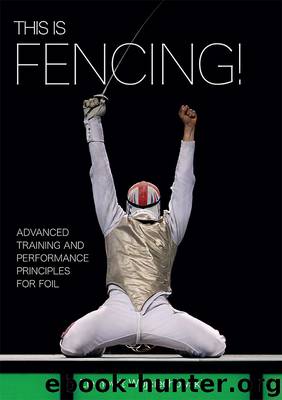This is Fencing! by Ziemowit Wojciechowski

Author:Ziemowit Wojciechowski
Language: eng
Format: epub
Publisher: Crowood
Systems of searching for the blade, practising standing still
•Octave, counter-octave, sixte, counter-sixte (8, c8, 6, c6)
•Quarte, counter-quarte, sixte, counter-sixte (4, c4, 6, c6)
•Septime, counter-septime, quarte, counter-quarte (7, c7, 4, c4)
•Counter-sixte, quarte, counter-quarte, sixte (c6, 4, c4, 6)
•Counter-sixte, counter-sixte, quarte, counter-quarte (c6, c6, 4, c4)
•Quarte, counter-quarte, septime, counter-septime (4, c4, 7, c7)
Here a fencer goes through all the positions in order and, when they do it well, the coach can ask them to riposte at any stage if the blade is found.
The next stage is to do this exercise while moving backwards and forwards, hitting after the blade is found while coordinating with distance. The parry should be held for long enough so the fencer has ample time to decide on a response depending on the coach’s next action. The coach should also encourage only point movements and reduce any movements of the guard parallel to the target. The guard should move along a straight line unless the exercise involves practising closing the opposite line while hitting.
In the later stages, the coach may change from deceiving the fencer’s blade to searching for the blade, requiring the fencer to change immediately to deceiving the coach’s blade while feeling for the right moment to hit the target.
Deceiving three prearranged parries with different footwork
The most typical distances from which a fencer should hit during the exercise are riposting, lunging and step-lunge. The coach initiates the exercise by taking the first of the three parries and decides the distance at the end of the movement. Here, common parries are two circular sixtes (6) and quarte (4). In order to develop acceleration, the coach tries to parry the fencer’s blade with a fourth parry, which in this case will be sixte (6) taken from quarte (4), the fencer’s task being to hit the target before this fourth parry can be taken.
Flèche attacks
From a standing position, starting when the fencer is ready. The focus of this exercise should be on execution. Possibilities include a flèche on the coach’s step forward, from pressing when the coach stops, after defending with distance, or as a riposte.
Knitting
This is a technical exercise, which I compare to a musician practising their scales. The coach engages the fencer’s blade, then the fencer changes the coach’s engagement before sliding along the blade while waiting for a reaction. Depending on the reaction, the fencer can choose from disengages or counter-disengages, hitting directly or with up to two deceptions and a lunge if the coach increases the distance and takes an extra parry. The coach may also deceive the fencer’s attempt to re-engage the blade; in this case, the fencer should first make a step back before taking successive parries (usually circular). This exercise develops the referee-friendly habit of reacting with a change of engagement to the blade being found, as well as training change of rhythm, coordination and responsive legs.
Hot and cold
While moving, the fencer constantly deceives the coach’s parries with cut-overs, without hitting, at slightly greater than lunging distance and, if the coach stops,
Download
This site does not store any files on its server. We only index and link to content provided by other sites. Please contact the content providers to delete copyright contents if any and email us, we'll remove relevant links or contents immediately.
Shoe Dog by Phil Knight(4167)
The Rules Do Not Apply by Ariel Levy(3906)
Walking by Henry David Thoreau(3234)
Running Barefoot by Amy Harmon(3056)
Crazy Is My Superpower by A.J. Mendez Brooks(2860)
How to Read Water: Clues and Patterns from Puddles to the Sea (Natural Navigation) by Tristan Gooley(2855)
I'll Give You the Sun by Jandy Nelson(2842)
How to Read Nature by Tristan Gooley(2665)
How Music Works by David Byrne(2525)
The Boy, the Mole, the Fox and the Horse by Charlie Mackesy(2448)
Seducing Cinderella by Gina L. Maxwell(2235)
Cuba by Lonely Planet(2184)
The Fight by Norman Mailer(2159)
Going Long by Editors of Runner's World(1921)
Accepted by Pat Patterson(1917)
The Unfettered Mind: Writings from a Zen Master to a Master Swordsman by Takuan Soho(1859)
The Happy Runner by David Roche(1821)
Backpacker the Complete Guide to Backpacking by Backpacker Magazine(1815)
Trail Magic by Trevelyan Quest Edwards & Hazel Edwards(1760)
